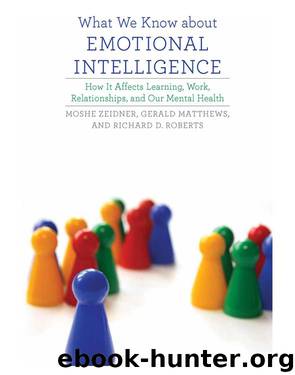What We Know about Emotional Intelligence by Moshe Zeidner

Author:Moshe Zeidner
Language: eng
Format: epub
Publisher: MIT Press
Table 8.1
Selected social-emotional learning intervention programs, including source, population, goals, EI content, and evaluation results
Program Source Population Goals EI content Evaluation results
Improving Social Awareness–Social Problem-Solving Project Elias et al. 1986; Clabby and Elias 1999 Grades K–12, with emphasis on elementary and middle school Improve problem-solving skills; enhance involvement; increase behavior and interpersonal effectiveness Students are taught skills in areas loosely overlapping with EI: awareness of feelings; self-control, anger, and stress management; emotion-focused coping, adaptability; and perspective taking. Students are taught to recognize emotions in pictures and facial expressions related to emotions. Emotional lessons merge naturally into reading and writing, health, science, and social studies. An initial evaluation of this program (Elias and Clabby, 1992) showed that it reduced the impact of typical middle school stressors. Follow-up evaluation six years later documented long-term gains in children’s prosocial behavior, sense of efficacy, and a reduction in pathology and socially disordered behaviors (aggression, vandalism). Program participants showed higher levels of positive prosocial behavior and lower levels of antisocial and self-destructive behavior. Elias et al. (1991) reported that students who had received a two-year social decision-making program in elementary schools showed higher levels of positive prosocial behavior and lower levels of antisocial self-destructive, and socially disordered behaviors when followed up in high school four to six years later than did the control students who had not received this program.
Promoting Alternative Thinking Strategies (PATHS) Greenberg et al. 1995 Grades K–12, with emphasis on younger children Improve children’s ability to: understand, express, and regulate emotions; understand perspective of others; solve social problems (1) Understanding, discussing, expressing and regulating negative emotions (e.g., anger); (2) controlling impulses; (3) empathic understanding of other’s feeling Program was effective for both low and high risk special students in grades 2 to 3 in improving emotional fluency and the range of vocabulary in discussing emotional experiences, in understanding of emotions, and efficacy beliefs regarding management of emotions and developmental aspects of some elements of emotions.
Resolving Conflicts Creatively Program (K–12) Aber et al. 1998 Grades K–12 Reduce youth violence by promoting constructive anger control and conflict resolution skills; improve inter-group relations; foster a caring and peaceful community of learners (1) Identifying one’s own negative feelings in conflict situations; (2) regulating anger in one’s self; (3) taking the perspective of others and empathizing with other’s feelings The program was evaluated based on two waves of developmental data. Those receiving a high number of lessons had a significantly slower growth in self-reported hostile attributions and teacher-reported aggressive behavior, compared to children receiving a low number of lessons (Aber et al. 1999). Patti and Lantieri (1999) report that more than 87 percent of the teachers said that RCCP was having a positive impact on their students. Also, about 92 percent of the student felt well about themselves and 64 percent of the teachers reported less physical roles.
Yale–New Haven Social Competence Promotion Program Shriver et al. 1999 Grades 5–8 Develop a sense of self worth; foster socially skilled and positive relations with peers and adults; engage in
Download
This site does not store any files on its server. We only index and link to content provided by other sites. Please contact the content providers to delete copyright contents if any and email us, we'll remove relevant links or contents immediately.
Should I Stay or Should I Go? by Ramani Durvasula(7523)
Why We Sleep: Unlocking the Power of Sleep and Dreams by Matthew Walker(6563)
Fear by Osho(4625)
Flow by Mihaly Csikszentmihalyi(4585)
Rising Strong by Brene Brown(4348)
Why We Sleep by Matthew Walker(4322)
The Hacking of the American Mind by Robert H. Lustig(4271)
How to Change Your Mind by Michael Pollan(4261)
Too Much and Not the Mood by Durga Chew-Bose(4237)
Lost Connections by Johann Hari(4009)
He's Just Not That Into You by Greg Behrendt & Liz Tuccillo(3811)
Evolve Your Brain by Joe Dispenza(3579)
The Courage to Be Disliked by Ichiro Kishimi & Fumitake Koga(3356)
Crazy Is My Superpower by A.J. Mendez Brooks(3277)
In Cold Blood by Truman Capote(3274)
Resisting Happiness by Matthew Kelly(3270)
What If This Were Enough? by Heather Havrilesky(3254)
The Book of Human Emotions by Tiffany Watt Smith(3203)
Descartes' Error by Antonio Damasio(3194)
